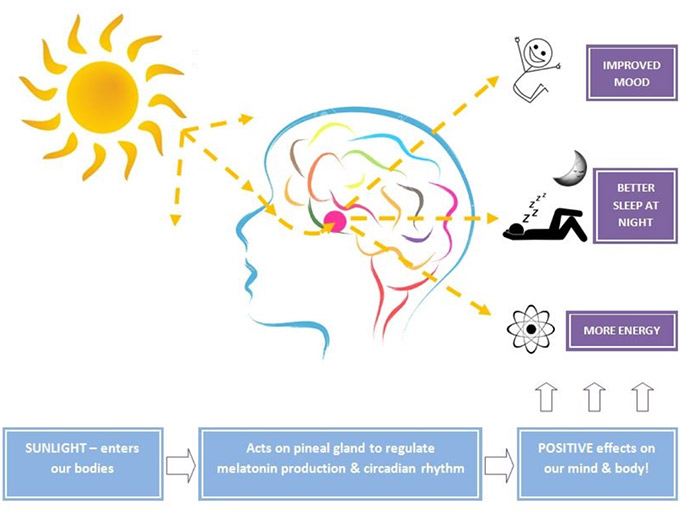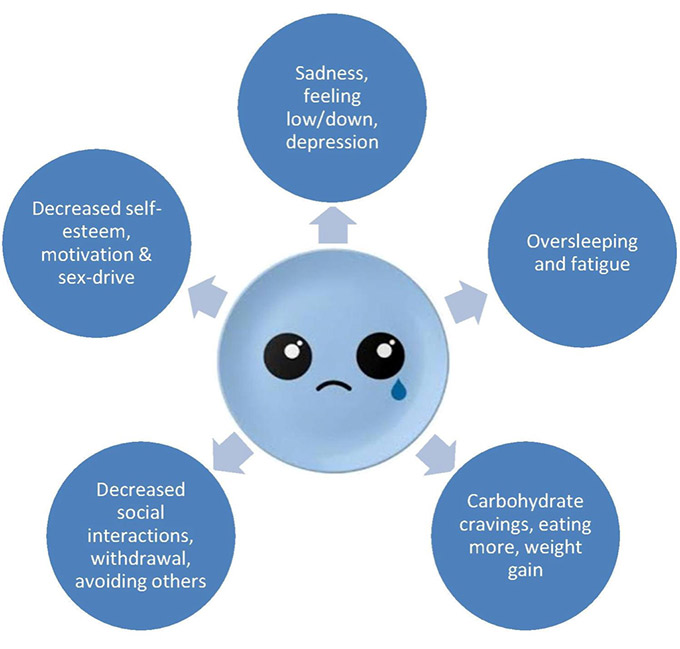As summer fades into the chills of fall and winter, many people find their overall mood drops into a bit of a sad slump. You might find yourself wanting to stay in bed rather than getting up, going out less, or eating more than you did in the summer months. If any of these indicators are feelings you experience as winter rolls in, you may have something called Seasonal Defective Disorder (SAD). What’s the difference between just a simple case of winter blues and SAD? Read on to find more, and to learn what you can do for your body to help!
Seasonal Affective Disorder (SAD) and “Winter Blues” are different, but exist on the same spectrum. As you can guess by the name the winter blues is a milder form of SAD. SAD is actually clinical depression with a seasonal pattern. The winter blues are more common, with rates of about 15% of the population that experience it. I would argue that it’s even more prevalent, but a frequent tendency is to look for and assign blame to ourselves or our life circumstances when we’re feeling down, and so it is likely many cases go undiagnosed.
Who is at risk for SAD?
As Calgarians, we’re at greater risk for SAD during fall and winter when we have shorter days. As the day’s length increases after the winter solstice, we gradually regain the light, but late fall and early winter particularly challenging times. Adults have the highest risk, but the likelihood declines after age 50. Women are up to eight times more likely to report having SAD; however reporting does not necessarily correlate to an increased risk. Most individuals with SAD have at least one close relative with a history of depression.
Why does SAD happen?
While there is no confirmed cause, SAD and Winter Blues seem to be related to seasonal variations in light. The pineal gland, a tiny gland in the brain, controls the production of melatonin, which sets our circadian rhythm: a biological clock that responds to changes in light. As the seasons change our circadian rhythm adapts by adjusting its melatonin production. It is possible that those with SAD and Winter Blues may actually over-produce melatonin as the winter days become darker, making them feel sleepy and lethargic.

Serotonin is also thought to play a role: this neurotransmitter is responsible for balancing your mood and its production decreases as sunlight diminishes in the fall. A decrease in serotonin activity leads to increases in depression and anxiety.
A lack of sunlight exposure on the skin in winter can lead to Vitamin D deficiency. Serotonin activity is believed to be connected to vitamin D production, and a deficiency in that has been associated with depressive symptoms.

What are the symptoms of SAD and Winter Blues?
Remember that SAD is a form of clinical depression, so the symptoms will be more exaggerated:
- Oversleeping and Fatigue
- Carbohydrate craving, eating more, weight gain
- Decreasing social interactions, withdrawal, or avoiding others
- Lowered self-esteem, motivation, and sex drive
- Sadness, feeling low, or depression
- Depressed mood occurring over at least two consecutive winters, alternating with non-depressed periods in the spring and summer (SAD)
What can I do about SAD?
- Consider light therapy. Studies on various types of light therapy have found low-intensity blue-enriched white light with an intensity of 750 lux effective, and equal to standard bright light at 10,000 lux. For those who are oversleeping, a dawn simulation light may be helpful. Educate yourself on the side effects and contraindications before use.
- Test and supplement with Vitamin D as needed. Evidence shows that low levels of Vitamin D are associated with depression; therefore, rectifying low and deficient values may improve symptoms of depression. Having your Vitamin D concentration measured (25-OH D) is helpful in knowing how much and for how long you should supplement to bring your bodily levels to optimal amounts (80-200nmol/L). While no longer covered by healthcare, Naturopathic Doctors can order this test for you in Alberta.
- Bundle up and get outside. You will likely still need additional support in winter, but there’s nothing like real, actual sunlight. Soak up as much sunshine as you can: it’s a vital nutrient that does much more than just provide Vitamin D. Even just a brisk walk outside can provide you with a combination of so many beneficial factors such as: fresh air, sunlight, exercise, and connection. If it’s dark when you leave and return from work, make a point of getting out for a walk at lunch. Outdoor activities are even better, as you tend to stay outside for longer and you get to have a lot of fun. If you’ve never tried a winter sport, it might be time to give it a try!
If you think you might be struggling with Seasonal Affective Disorder or the Winter Blues and would like some one-on-one support with it, consider booking an appointment with me.
